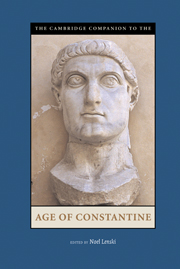Book contents
- Frontmatter
- Introduction
- 1 Sources for the History of Constantine
- Section 1 Politics and Personalities
- Section II Religion and Spiritual Life
- Section III Law and Society
- 8 Bureaucracy and Government
- 9 Civil Law and Social Life
- 10 Economy and Society
- Section IV Art and Culture
- Section V Empire and Beyond
- Appendix 1: Stemmata
- Appendix 2: Timeline
- Maps
- Primary Sources and Translations
- Secondary Bibliography
- Index
10 - Economy and Society
from Section III - Law and Society
Published online by Cambridge University Press: 28 September 2007
- Frontmatter
- Introduction
- 1 Sources for the History of Constantine
- Section 1 Politics and Personalities
- Section II Religion and Spiritual Life
- Section III Law and Society
- 8 Bureaucracy and Government
- 9 Civil Law and Social Life
- 10 Economy and Society
- Section IV Art and Culture
- Section V Empire and Beyond
- Appendix 1: Stemmata
- Appendix 2: Timeline
- Maps
- Primary Sources and Translations
- Secondary Bibliography
- Index
Summary
A Difficult Period?
From an economic perspective, it is difficult to speak of a “Constantinian period.” The economy, in contrast with legislation or politics, evolved slowly. Thus, regardless of whether we think of the Constaninian period as the short duration of Constantine’s sole rule, the period of his entire reign, or even more broadly the period of his family dynasty, we still fail to arrive at the long and slow process whereby economies change. If, however, we understand Constantine’s reign as part of a larger period of late antiquity, it must first be stated that, from an economic perspective, it was a period many have characterized as troubled. Some attribute this to natural disasters: seismic activity in Greece, for example, seems to have increased in the period of the fourth to sixth centuries relative to the previous nine hundred years. Others have argued that climatic change around the Mediterranean and in western Europe - particularly a third-century shift to a much cooler and drier climate and a net rise in sea level - led to reforestations, swampification, and the decline of settled agriculture. The consequences could obviously have been profound, including increased mortality rates, a decline in agricultural production, and even increased pressure from barbarian peoples hoping to migrate to more temperate regions. Unfortunately, no cause-to-effect links between these geographical phenomena and the contemporary economy can be measured directly in the sources available to us.
- Type
- Chapter
- Information
- The Cambridge Companion to the Age of Constantine , pp. 226 - 252Publisher: Cambridge University PressPrint publication year: 2005
- 2
- Cited by

